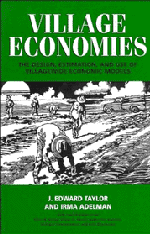Book contents
- Frontmatter
- Contents
- Acknowledgments
- 1 Introduction
- 2 Modeling village economies
- 3 The village economy and tenure security in West Africa: A Senegalese village SAM
- 4 Production and distribution in a dry-land village economy
- 5 Migration and the changing structure of a Mexican village economy
- 6 Economic linkages in a small regional economy: The case of Kutus Region, Kenya
- 7 Household nutrition and economic linkages: A village social accounting matrix for West Java, Indonesia
- 8 The village CGE: Basic model and estimation
- 9 Policy simulations
- 10 Conclusions
- Bibliography
- Index
3 - The village economy and tenure security in West Africa: A Senegalese village SAM
Published online by Cambridge University Press: 05 June 2012
- Frontmatter
- Contents
- Acknowledgments
- 1 Introduction
- 2 Modeling village economies
- 3 The village economy and tenure security in West Africa: A Senegalese village SAM
- 4 Production and distribution in a dry-land village economy
- 5 Migration and the changing structure of a Mexican village economy
- 6 Economic linkages in a small regional economy: The case of Kutus Region, Kenya
- 7 Household nutrition and economic linkages: A village social accounting matrix for West Java, Indonesia
- 8 The village CGE: Basic model and estimation
- 9 Policy simulations
- 10 Conclusions
- Bibliography
- Index
Summary
The bulk of Senegal's population lives and farms in the Peanut Basin. This region extends southward from Louga to Kaolack and eastward from Thies to Tiaf and broadly follows the historical and current distribution of peanut production in Senegal. It is also the area that has suffered the most from environmental degradation. Overworked soil, deforestation, overgrazing, wind erosion, a falling water table, and salinization are all weakening the economic base of the Peanut Basin farmers.
A hypothesis frequently advanced to explain environmental degradation in the Peanut Basin is that the insecurity of traditional landholdings discourages investment in soil conservation. The legal land tenure system in Senegal is complex. A Law of National Domain passed in 1964 granted the state ownership rights in previously unregistered land. With this law, approximately 98 percent of all Senegalese land became part of the national domain and consequently fell under state control. However, due to incomplete and uneven application of the law, usufruct or ownership rights over most agricultural land are still determined through traditional practice.
This chapter has two main objectives. The first is to use a village social accounting matrix to explore the role of secure and insecure landholdings and the role of the institutions (compounds) that govern their use in two villages in the Senegalese Peanut Basin. The second is to compare income flows and soil conservation practices between the two villages, which have differing degrees of soil insecurity.
- Type
- Chapter
- Information
- Village EconomiesThe Design, Estimation, and Use of Villagewide Economic Models, pp. 31 - 58Publisher: Cambridge University PressPrint publication year: 1996



